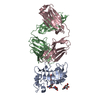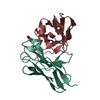[English] 日本語
 Yorodumi
Yorodumi- PDB-7yc5: Cryo-EM structure of SARS-CoV-2 spike in complex with K202.B bisp... -
+ Open data
Open data
- Basic information
Basic information
| Entry | Database: PDB / ID: 7yc5 | ||||||
|---|---|---|---|---|---|---|---|
| Title | Cryo-EM structure of SARS-CoV-2 spike in complex with K202.B bispecific antibody | ||||||
 Components Components |
| ||||||
 Keywords Keywords |  VIRAL PROTEIN/IMMUNE SYSTEM / VIRAL PROTEIN/IMMUNE SYSTEM /  spike protein / spike protein /  antibody / antibody /  bispecific antibody / bispecific antibody /  VIRAL PROTEIN-IMMUNE SYSTEM COMPLEX VIRAL PROTEIN-IMMUNE SYSTEM COMPLEX | ||||||
| Function / homology |  Function and homology information Function and homology informationMaturation of spike protein / viral translation / Translation of Structural Proteins / Virion Assembly and Release / host cell surface / host extracellular space / suppression by virus of host tetherin activity / Induction of Cell-Cell Fusion / structural constituent of virion / entry receptor-mediated virion attachment to host cell ...Maturation of spike protein / viral translation / Translation of Structural Proteins / Virion Assembly and Release / host cell surface / host extracellular space / suppression by virus of host tetherin activity / Induction of Cell-Cell Fusion / structural constituent of virion / entry receptor-mediated virion attachment to host cell / host cell endoplasmic reticulum-Golgi intermediate compartment membrane / receptor-mediated endocytosis of virus by host cell / Attachment and Entry /  membrane fusion / positive regulation of viral entry into host cell / receptor-mediated virion attachment to host cell / membrane fusion / positive regulation of viral entry into host cell / receptor-mediated virion attachment to host cell /  receptor ligand activity / host cell surface receptor binding / fusion of virus membrane with host plasma membrane / fusion of virus membrane with host endosome membrane / receptor ligand activity / host cell surface receptor binding / fusion of virus membrane with host plasma membrane / fusion of virus membrane with host endosome membrane /  viral envelope / symbiont-mediated suppression of host type I interferon-mediated signaling pathway / virion attachment to host cell / SARS-CoV-2 activates/modulates innate and adaptive immune responses / host cell plasma membrane / virion membrane / viral envelope / symbiont-mediated suppression of host type I interferon-mediated signaling pathway / virion attachment to host cell / SARS-CoV-2 activates/modulates innate and adaptive immune responses / host cell plasma membrane / virion membrane /  membrane / identical protein binding / membrane / identical protein binding /  plasma membrane plasma membraneSimilarity search - Function | ||||||
| Biological species |   Severe acute respiratory syndrome coronavirus 2 Severe acute respiratory syndrome coronavirus 2  Homo sapiens (human) Homo sapiens (human) | ||||||
| Method |  ELECTRON MICROSCOPY / ELECTRON MICROSCOPY /  single particle reconstruction / single particle reconstruction /  cryo EM / Resolution: 3.1 Å cryo EM / Resolution: 3.1 Å | ||||||
 Authors Authors | Yoo, Y. / Cho, H.S. | ||||||
| Funding support |  Korea, Republic Of, 1items Korea, Republic Of, 1items
| ||||||
 Citation Citation |  Journal: Antiviral Res / Year: 2023 Journal: Antiviral Res / Year: 2023Title: Novel bispecific human antibody platform specifically targeting a fully open spike conformation potently neutralizes multiple SARS-CoV-2 variants. Authors: Ji Woong Kim / Kyun Heo / Hyun Jung Kim / Youngki Yoo / Hyun-Soo Cho / Hui Jeong Jang / Ho-Young Lee / In Young Ko / Ju Rang Woo / Yea Bin Cho / Ji Hyun Lee / Ha Rim Yang / Ha Gyeong Shin / ...Authors: Ji Woong Kim / Kyun Heo / Hyun Jung Kim / Youngki Yoo / Hyun-Soo Cho / Hui Jeong Jang / Ho-Young Lee / In Young Ko / Ju Rang Woo / Yea Bin Cho / Ji Hyun Lee / Ha Rim Yang / Ha Gyeong Shin / Hye Lim Choi / Kyusang Hwang / Sokho Kim / Hanseong Kim / Kwangrok Chun / Sukmook Lee /  Abstract: Rapid emergence of new variants of severe acute respiratory syndrome coronavirus 2 (SARS-CoV-2) has prompted an urgent need for the development of broadly applicable and potently neutralizing ...Rapid emergence of new variants of severe acute respiratory syndrome coronavirus 2 (SARS-CoV-2) has prompted an urgent need for the development of broadly applicable and potently neutralizing antibody platform against the SARS-CoV-2, which can be used for combatting the coronavirus disease 2019 (COVID-19). In this study, based on a noncompeting pair of phage display-derived human monoclonal antibodies (mAbs) specific to the receptor-binding domain (RBD) of SARS-CoV-2 isolated from human synthetic antibody library, we generated K202.B, a novel engineered bispecific antibody with an immunoglobulin G4-single-chain variable fragment design, with sub- or low nanomolar antigen-binding avidity. Compared with the parental mAbs or mAb cocktail, the K202.B antibody showed superior neutralizing potential against a variety of SARS-CoV-2 variants in vitro. Furthermore, structural analysis of bispecific antibody-antigen complexes using cryo-electron microscopy revealed the mode of action of K202.B complexed with a fully open three-RBD-up conformation of SARS-CoV-2 trimeric spike proteins by simultaneously interconnecting two independent epitopes of the SARS-CoV-2 RBD via inter-protomer interactions. Intravenous monotherapy using K202.B exhibited potent neutralizing activity in SARS-CoV-2 wild-type- and B.1.617.2 variant-infected mouse models, without significant toxicity in vivo. The results indicate that this novel approach of development of immunoglobulin G4-based bispecific antibody from an established human recombinant antibody library is likely to be an effective strategy for the rapid development of bispecific antibodies, and timely management against fast-evolving SARS-CoV-2 variants. | ||||||
| History |
|
- Structure visualization
Structure visualization
| Structure viewer | Molecule:  Molmil Molmil Jmol/JSmol Jmol/JSmol |
|---|
- Downloads & links
Downloads & links
- Download
Download
| PDBx/mmCIF format |  7yc5.cif.gz 7yc5.cif.gz | 1016.3 KB | Display |  PDBx/mmCIF format PDBx/mmCIF format |
|---|---|---|---|---|
| PDB format |  pdb7yc5.ent.gz pdb7yc5.ent.gz | 793.8 KB | Display |  PDB format PDB format |
| PDBx/mmJSON format |  7yc5.json.gz 7yc5.json.gz | Tree view |  PDBx/mmJSON format PDBx/mmJSON format | |
| Others |  Other downloads Other downloads |
-Validation report
| Arichive directory |  https://data.pdbj.org/pub/pdb/validation_reports/yc/7yc5 https://data.pdbj.org/pub/pdb/validation_reports/yc/7yc5 ftp://data.pdbj.org/pub/pdb/validation_reports/yc/7yc5 ftp://data.pdbj.org/pub/pdb/validation_reports/yc/7yc5 | HTTPS FTP |
|---|
-Related structure data
| Related structure data |  33734MC M: map data used to model this data C: citing same article ( |
|---|---|
| Similar structure data | Similarity search - Function & homology  F&H Search F&H Search |
- Links
Links
- Assembly
Assembly
| Deposited unit | 
|
|---|---|
| 1 |
|
- Components
Components
| #1: Protein |  Spike protein / S glycoprotein / E2 / Peplomer protein Spike protein / S glycoprotein / E2 / Peplomer proteinMass: 133781.312 Da / Num. of mol.: 3 Mutation: R682G, R683S, R685S, F817P, A892P, A899P, A942P, K986P, V987P Source method: isolated from a genetically manipulated source Source: (gene. exp.)   Severe acute respiratory syndrome coronavirus 2 Severe acute respiratory syndrome coronavirus 2Gene: S, 2 / Cell (production host): Sf9 / Production host:   Spodoptera frugiperda (fall armyworm) / References: UniProt: P0DTC2 Spodoptera frugiperda (fall armyworm) / References: UniProt: P0DTC2#2: Antibody |  Mass: 49646.191 Da / Num. of mol.: 3 Source method: isolated from a genetically manipulated source Source: (gene. exp.)   Homo sapiens (human) / Cell line (production host): Expi293 / Production host: Homo sapiens (human) / Cell line (production host): Expi293 / Production host:   Homo sapiens (human) Homo sapiens (human)#3: Antibody | Mass: 49846.777 Da / Num. of mol.: 3 Source method: isolated from a genetically manipulated source Source: (gene. exp.)   Homo sapiens (human) / Cell line (production host): Expi293 / Production host: Homo sapiens (human) / Cell line (production host): Expi293 / Production host:   Homo sapiens (human) Homo sapiens (human)#4: Sugar | ChemComp-NAG /  N-Acetylglucosamine N-AcetylglucosamineHas ligand of interest | N | |
|---|
-Experimental details
-Experiment
| Experiment | Method:  ELECTRON MICROSCOPY ELECTRON MICROSCOPY |
|---|---|
| EM experiment | Aggregation state: PARTICLE / 3D reconstruction method:  single particle reconstruction single particle reconstruction |
- Sample preparation
Sample preparation
| Component |
| ||||||||||||||||||||||||
|---|---|---|---|---|---|---|---|---|---|---|---|---|---|---|---|---|---|---|---|---|---|---|---|---|---|
| Molecular weight |
| ||||||||||||||||||||||||
| Source (natural) |
| ||||||||||||||||||||||||
| Source (recombinant) |
| ||||||||||||||||||||||||
| Buffer solution | pH: 7.5 | ||||||||||||||||||||||||
| Specimen | Embedding applied: NO / Shadowing applied: NO / Staining applied : NO / Vitrification applied : NO / Vitrification applied : YES : YES | ||||||||||||||||||||||||
| Specimen support | Grid material: COPPER / Grid mesh size: 200 divisions/in. / Grid type: Quantifoil R1.2/1.3 | ||||||||||||||||||||||||
Vitrification | Cryogen name: ETHANE / Humidity: 100 % |
- Electron microscopy imaging
Electron microscopy imaging
| Experimental equipment |  Model: Titan Krios / Image courtesy: FEI Company |
|---|---|
| Microscopy | Model: FEI TITAN KRIOS |
| Electron gun | Electron source : :  FIELD EMISSION GUN / Accelerating voltage: 300 kV / Illumination mode: FLOOD BEAM FIELD EMISSION GUN / Accelerating voltage: 300 kV / Illumination mode: FLOOD BEAM |
| Electron lens | Mode: BRIGHT FIELD Bright-field microscopy / Nominal defocus max: 2700 nm / Nominal defocus min: 600 nm / Alignment procedure: ZEMLIN TABLEAU Bright-field microscopy / Nominal defocus max: 2700 nm / Nominal defocus min: 600 nm / Alignment procedure: ZEMLIN TABLEAU |
| Specimen holder | Cryogen: NITROGEN |
| Image recording | Electron dose: 45 e/Å2 / Film or detector model: FEI FALCON IV (4k x 4k) |
- Processing
Processing
| Software |
| ||||||||||||||||||||||||||||
|---|---|---|---|---|---|---|---|---|---|---|---|---|---|---|---|---|---|---|---|---|---|---|---|---|---|---|---|---|---|
| EM software |
| ||||||||||||||||||||||||||||
CTF correction | Type: PHASE FLIPPING ONLY | ||||||||||||||||||||||||||||
| Particle selection | Num. of particles selected: 1086347 | ||||||||||||||||||||||||||||
| Symmetry | Point symmetry : C1 (asymmetric) : C1 (asymmetric) | ||||||||||||||||||||||||||||
3D reconstruction | Resolution: 3.1 Å / Resolution method: FSC 0.143 CUT-OFF / Num. of particles: 182595 / Symmetry type: POINT | ||||||||||||||||||||||||||||
| Atomic model building | Protocol: FLEXIBLE FIT | ||||||||||||||||||||||||||||
| Atomic model building |
| ||||||||||||||||||||||||||||
| Refinement | Cross valid method: NONE |
 Movie
Movie Controller
Controller


 PDBj
PDBj









